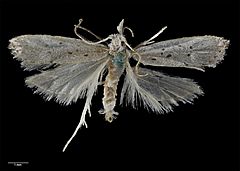Paramorpha marginata facts for kids
Quick facts for kids Paramorpha marginata |
|
|---|---|
 |
|
| Male holotype specimen | |
| Scientific classification | |
| Kingdom: | |
| Phylum: | |
| Class: | |
| Order: | |
| Family: |
Carposinidae
|
| Genus: |
Paramorpha
|
| Species: |
P. marginata
|
| Binomial name | |
| Paramorpha marginata (Philpott, 1931)
|
|
| Synonyms | |
|
|
Paramorpha marginata is a species of moth in the family Carposinidae. It is endemic to New Zealand.
Contents
Taxonomy
This species was described by Alfred Philpott in 1931 using a specimen collected by Charles E. Clarke at Okoroire in December and named Carposina marginata. Later in 1931 Edward Meyrick, thinking he was describing a new species, named it Paramorpha heptacentra. This name along with the original combination were synonymised by George Hudson in his 1939 book A supplement to the butterflies and moths of New Zealand. Hudson illustrated and described the species under the current nomenclature. The male holotype specimen is held at the Auckland War Memorial Museum.
Description
Philpott described the species as follows:
♂. 11 mm. Head and thorax white. Palpi white, fuscous laterally and beneath. Antennae white, ciliations in ♂ 2. Abdomen ochreous white. Legs fuscous mixed with whitish, posterior pair white. Forewings with costa moderately arched, apex rather angular, termen rounded, oblique; white, rather greyish except along costa; extreme edge of costa yellow more dilated on apical ½; markings black; a spot below fold at ¼; a spot well below costa at about ¼ and another immediately beneath it; a large spot just above fold not far beyond the latter; a spot below costa at ½; beyond this a spot in disc and another beneath and obliquely before it; a chain of spots round termen and a number of single black scales scattered about apical half of wing: fringes grey. Hindwings and fringes shining white.
Distribution
This species is endemic to New Zealand. Hudson was of the opinion that the species could be found in the northern parts of the North island. Other than Okoroire, this species has been collected in Whangarei, and at the Poor Knights Islands.
Biology and behaviour
This species is on the wing in December and January. This species has been collected using a malaise trap as well as being beaten from foliage.
Habitat and host species
This moth has been found to be present in the canopy of kanuka stands. P. marginata has been collected and reared from litter beneath Leucopogon fasciculatus.
Images for kids



